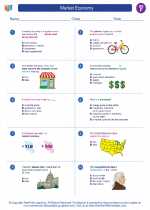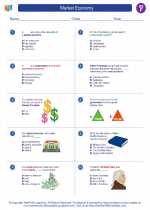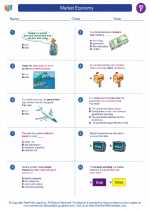Market Economy
What is a Market Economy? An economic system is the way a country makes and sells goods. In some countries, the government is in charge of what people buy and sell. In a market economy, people choose what goods and services they want to buy. They also choose where they want to work and what they want to do. Read More...
◂Social Studies Worksheets and Study Guides Sixth Grade. Market Economy
Study Guide Market Economy
Market Economy  Worksheet/Answer key
Worksheet/Answer key Market Economy
Market Economy  Worksheet/Answer key
Worksheet/Answer key Market Economy
Market Economy  Worksheet/Answer key
Worksheet/Answer key Market Economy
Market Economy 

 Worksheet/Answer key
Worksheet/Answer key
 Worksheet/Answer key
Worksheet/Answer key
 Worksheet/Answer key
Worksheet/Answer key

The resources above cover the following skills:
National Curriculum Standards for Social Studies (NCSS)
PRODUCTION, DISTRIBUTION, AND CONSUMPTION
SOCIAL STUDIES PROGRAMS SHOULD INCLUDE EXPERIENCES THAT PROVIDE FOR THE STUDY OF HOW PEOPLE ORGANIZE FOR THE PRODUCTION, DISTRIBUTION, AND CONSUMPTION OF GOODS AND SERVICES.
KNOWLEDGE - Learners will understand:
How markets bring buyers and sellers together to exchange goods and services.
How goods and services are allocated in a market economy through the influence of prices on decisions about production and consumption.
GLOBAL CONNECTIONS
SOCIAL STUDIES PROGRAMS SHOULD INCLUDE EXPERIENCES THAT PROVIDE FOR THE STUDY OF GLOBAL CONNECTIONS AND INTERDEPENDENCE.
KNOWLEDGE - Learners will understand:
Global factors such as cultural, economic, and political connections are changing the places in which people live (e.g., through trade, migration, increased travel, and communication).
PROCESSES - Learners will be able to:
Describe and explain the relationships and tensions between national sovereignty and global interests in such matters as territorial rights, natural resources, trade, the different uses of technology, and the welfare of people.
National Standards for Civics and Government (NSCG)
What are the foundations of the American political system? What are the distinctive characteristics of American society?
Distinctive characteristics of American society. Students should be able to identify and explain the importance of historical experience and geographic, social, and economic factors that have helped to shape American society. To achieve this standard, students should be able to
Explain important factors that have helped shape American society
Market economy
What is the relationship of the United States to other nations and to world affairs? How is the world organized politically?
Interaction among nation-states. Students should be able to explain how nation-states interact with each other. To achieve this standard, students should be able to
Describe the most important means nation-states use to interact with one another
Trade
National Content Standards in Economics (NCSE)
Allocation
Students will understand that different methods can be used to allocate goods and services. People acting individually or collectively must choose which methods to use to allocate different kinds of goods and services. Students will be able to use this knowledge to evaluate different methods of allocating goods and services, by comparing the benefits to the costs of each method.
At the completion of Grade 8, students will know the Grade 4 benchmarks for this standard, and also that:
There are essential differences between a market economy, in which allocations result from individuals making decisions as buyers and sellers, and a command economy, in which resources are allocated according to central authority.
National economies vary in the extent to which they rely on government directives (central planning) and signals (prices) from private markets to allocate scarce goods, services, and productive resources.
As consumers, people use resources in different ways to satisfy different wants. Productive resources can be used in different ways to produce different goods and services.
Trade
Students will understand that voluntary exchange occurs only when all participating parties expect to gain. This is true for trade among individuals or organizations within a nation, and among individuals or organizations in different nations. Students will be able to use this knowledge to negotiate exchanges and identify the gains to themselves and others. Compare the benefits and costs of policies that alter trade barriers between nations, such as tariffs and quotas.
At the completion of Grade 8, students will know the Grade 4 benchmarks for this standard, and also that:
Free trade increases worldwide material standards of living.
The gains from free trade are not distributed equally, and some individuals or groups may lose more than they gain when trade barriers are reduced.
Despite the mutual benefits from trade among people in different countries, many nations employ trade barriers to restrict free trade for national defense reasons, to protect key industries, or because some companies and workers are hurt by free trade.
Markets and Prices
Students will understand that a market exists when buyers and sellers interact. This interaction determines market prices and thereby allocates scarce goods and services. Students will be able to use this knowledge to identify markets in which they have participated as a buyer and as a seller and describe how the interaction of all buyers and sellers influences prices. Also, predict how prices change when there is either a shortage or surplus of the product available.
At the completion of Grade 8, students will use this knowledge to:
Identify examples of products for which the price fell because sellers did not sell all they had produced at the initial price; identify examples of other products for which the price rose because consumers wanted to buy more than producers were producing at the initial price.
National Center for History in Schools (NCHS)
World History Content Standards
Era 9: The 20th Century Since 1945: Promises and Paradoxes
The search for community, stability, and peace in an interdependent world.
The student understands how liberal democracy, market economies, and human rights movements have reshaped political and social life.